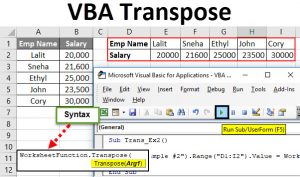Mastering Excel VBA: Transpose Range Techniques

Excel Visual Basic for Applications (VBA) is a powerful tool that enables users to automate tasks, manipulate data, and create dynamic solutions within the Microsoft Excel ecosystem. Among the myriad of techniques VBA offers, transposing ranges stands out as an essential skill for data manipulation and presentation. Transposing ranges allows you to rotate data, turning rows into columns and vice versa, which is particularly useful when dealing with datasets that need to be reformatted for better visualization or analysis.
Understanding the Transpose Range Command

The Transpose Range command in Excel VBA is a built-in function that allows you to quickly rearrange the orientation of data within a specified range. It’s particularly useful when you need to transform data for presentation, analysis, or compatibility with other systems or processes. The command is straightforward to use and can be a powerful tool in your VBA toolkit.
The Syntax and Usage
The basic syntax for the Transpose Range command is straightforward: Range(“SourceRange”).Transpose(Destination). Here’s a breakdown:
- SourceRange: This is the range of cells you want to transpose. For example,
Range("A1:B5")selects the cells from A1 to B5. - Destination: This is the location where you want the transposed data to be placed. For instance,
Range("C1")would place the transposed data starting from cell C1.
Here's a simple example to illustrate its usage:
Sub Transpose_Example()
Range("A1:B5").Transpose Destination:=Range("C1")
End Sub
In this example, the data in the range A1:B5 will be transposed and placed starting from cell C1.
Advanced Transpose Techniques
While the basic Transpose command is straightforward, there are more advanced techniques you can employ to customize your transposition. Here are a few:
- Transposing Multiple Ranges: You can transpose multiple ranges simultaneously by using an array. This is particularly useful when you have multiple datasets to transpose.
- Transposing with Dynamic Ranges: By using VBA's dynamic range capabilities, you can transpose data even if the range isn't fixed. This is ideal for situations where the data size or location may change.
- Combining Transpose with Other Functions: Transpose can be combined with other VBA functions to create powerful data manipulation routines. For instance, you can transpose data and then apply formulas to the transposed data.
Best Practices and Considerations

When working with the Transpose Range command, there are a few best practices and considerations to keep in mind:
- Data Consistency: Ensure that your data is consistent in structure. The Transpose command will maintain the order of data, so if your source data isn't in a logical order, the transposed data might not make sense.
- Destination Range: Always ensure that your destination range is clear of data. Transposing over existing data can lead to data loss.
- Error Handling: Implement error handling in your VBA code to manage situations where the source or destination range might be invalid.
Real-World Applications
The Transpose Range command has a wide range of applications in data manipulation and analysis. Here are a few real-world scenarios where it can be invaluable:
- Data Presentation: Transposing data can be a quick way to present data in a more visually appealing or understandable format, especially for reports or dashboards.
- Data Analysis: By transposing data, you can easily switch between row-based and column-based analyses, which is crucial for certain types of statistical or financial analyses.
- Data Import/Export: When importing or exporting data to/from other systems, you might need to transpose data to match the format of the target system.
Conclusion: Elevating Your Data Manipulation Skills
Mastering the Transpose Range command in Excel VBA is a crucial step in elevating your data manipulation skills. By understanding how to effectively use this command, you can transform data with ease, making your analyses and presentations more efficient and visually appealing. As with any VBA skill, practice and experimentation are key to mastering the art of transposing ranges.
FAQ

Can I transpose data without overwriting existing data in the destination range?
+Yes, you can use VBA’s dynamic range capabilities to specify a unique destination range for each transposition. This way, you can avoid overwriting existing data.
What happens if my source range has formulas or functions?
+The Transpose command will maintain the formulas or functions in the transposed data. However, the cell references might change, so you might need to adjust the formulas accordingly.
Is there a way to transpose data without using VBA?
+Yes, Excel has a built-in feature to transpose data. You can access it by selecting the data, going to the “Home” tab, clicking on “Paste,” and then selecting “Transpose.”



